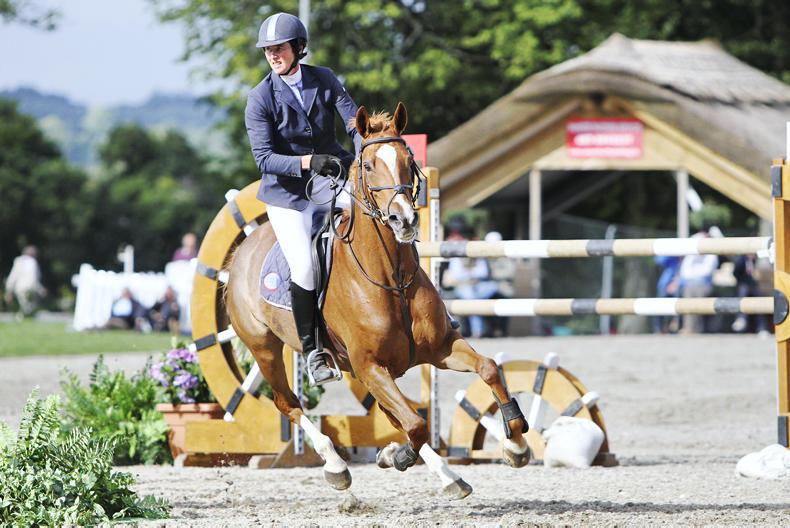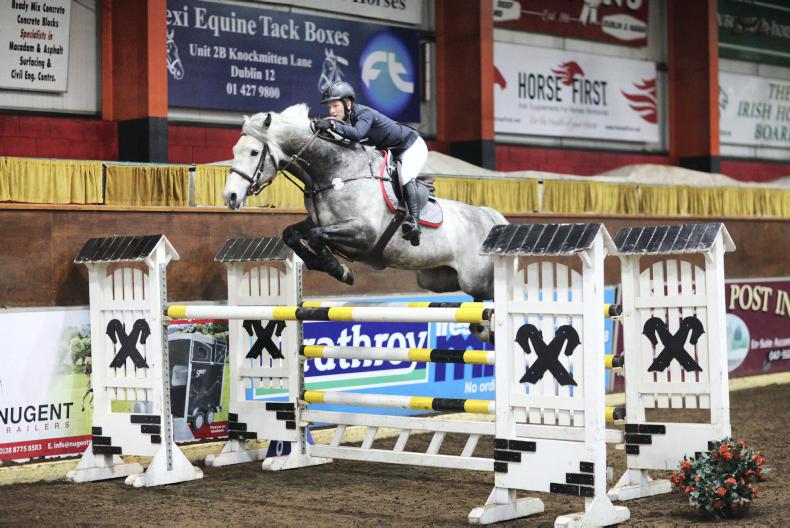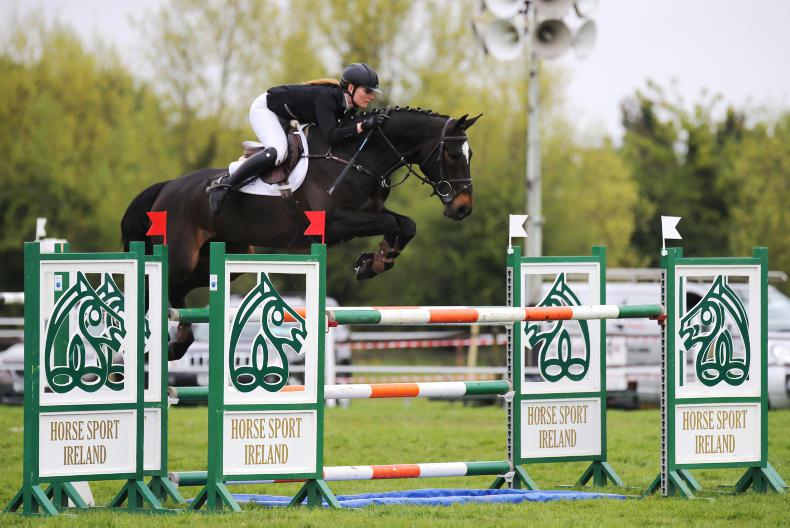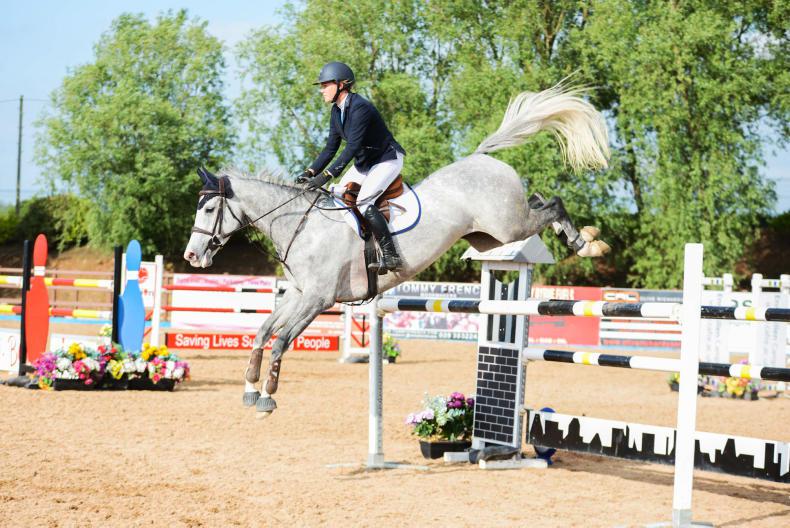JESSICA BURKE
A FAMILIER face when it comes to producing young horses in Ireland is Galway’s Jessica Burke. While at college, Jessica worked with Marie Burke at Clare Equestrian Centre and this is where she got her first taste of riding young horses.
Burke’s most notable success was winning both the four-year-old and the six-year-old championship at the Dublin Horse Show in 2017 and being selected to represent Ireland with two horses at the 2017 World Breeding Championships for Young Horses in Lanaken.
She also won both the five and six-year-old ISH Studbook titles in 2017 and was runner-up in the seven-year-old series.
Other successes include the sale of some of horses like Woodfield Samenco, GRC Paris, Lux Like Jagger and Galloways Gold, to keep the business going.
“I really enjoyed working with the youngsters, starting them off and seeing them improve throughout the summer. I realised how some of the horses are very intelligent and learn very quick and this is where I get satisfaction from.
“I bought a three-year-old by Lux Z and started to produce him myself back in 2012 and that is when I began producing horses at home. This was essentially the beginning of my business.”
Similar to Moloney, Burke says there is no exact time limit when it comes to producing young horses. “Some horses are much slower than others so it can be frustrating at times. It takes a horse until he/she is at least eight to be able to compete at the top level.”
Every horse is different, she explains. “I try to do as little as possible with four-year-olds, again depending on the type of horse. A very big scopey horse may not necessarily feel great at the jump until he is about six because it takes them longer to canter, but you should still be able to see the potential.
“Other horses, often a smaller more compact type with a smaller canter, can feel very good from an early age but you must try to judge how much scope they will have at the end of the day.”
Burke is positive about the state of the market. “These days there is a good market for all types of horses as long as they are sound and good models. But they can only be sold if they are rideable, therefore the flat work and education that goes into all of the horses from the beginning is the same.
“The best market is abroad, so we are trying to encourage more and more of the foreigners to buy their young horses in Ireland. I’m lucky I have solid group of owners that send me their horses to produce from the beginning.
“We try to make a call on the future of these horses as early as possible. This is probably the biggest challenge as it is very hard to say how much potential they actually have at the beginning and if they will go to the very top. Making this call is one of the most important things and from my experience over the last 10 years, I now feel l can spot a top horse from a very young age.”
Just five years ago Burke made the move into breeding horses, using her young rider mare Amanda 202, who retired early. “I have some lovely youngsters off her by Chippison, Kannan, Ard VDL Douglas and Chin Chin. The Kannan is the only filly so I plan to take some embryos off her and keep her for breeding in the future.
“I’m also trying to breed and take embryos off my older mare Vitesse, who competed until she was 18. We also breed from two other mares by Ramiro B and Cruising.
“I plan to concentrate on breeding from a small number of good mares and I will try to take an embryo from any of the really good mares that I am competing so if they are sold on I have something to look forward to.
“I am also looking forward to an embryo taken from last year’s four-old year old champion Lux A Special Lady. She is a full-sister to 1.60m campaigner Special Lux,” the Galway show jumper added.
LINDA MOLONEY

BASED in Kilkenny, Linda Moloney has been producing young horses for 20 years and breeding for 15 of those. Despite the hard work, it’s something that she wouldn’t change.
Just some of her success stories include On A Frolic, Notting Hill, Malibu Flight, Meribel Flight, Dino, Mavouka Flight, Lord Pitzi, Woodenfarm Milly, Cornelia, Zilko, Simona Flight and Knightfield Arlie.
“This jobs involves many unsociable hours, but to do this job well, you need to love it and the lifestyle that it involves,” Moloney said.
Success doesn’t happen overnight and Moloney aims to keep horses until there are eight or nine.
In identifying a potential showjumper she looks for a good balanced canter and a nice temperament. “I obviously would look for scope, carefulness and good technique, but I find that if a horse has a good canter and temperament, it will make a nice horse even if it’s not a show jumping star.”
Of course there are no guarantees in producing horses, but deciding if it’s going to make it can take time and investment. “I think if a horse is comfortable to step up from six-year-old level to what it needs to do as a seven-year-old, you can be quite sure it’s a potential top horse.
“Before that you can speculate and go by your gut feeling, but I don’t believe you can be sure of potential for the top before the horse is actually in the ring as a seven-year-old and is happy to jump the tracks.”
What does Moloney aim for at the start of the year with a horse who is just starting its career? “At four, the young horse is starting its competitive career and at the start of the year I’d like to have it jumping around a small course of fences. Once it’s doing that I don’t believe it’s any big panic to get it jumping bigger, let it jump around 80/90cm for a few months to get comfortable and get the riding right, flying changes etc.”
The quality of venues in Ireland is a big problem for horse producers and Moloney is among those who feels we need more support from the government.
“The lack of venues in this country must be named as the biggest challenge. In order to produce horses, they need to be brought to different places and venues to get used to different environments. Funding from the government to provide equestrianism with new venues is essential if we are going to continue to be a strong nation to produce good horses.”
Most of Moloney’s horses are sold abroad and she said that everything is always for sale.
“If we have a really good horse, it will only be sold if the right buyer comes along and is willing to pay what we are asking,” she added.
JOAN GREENE

PRODUCING horses for 25 years for herself and others, Joan Greene has been involved in the careers of many young stars in Ireland. She boasts an impressive record which includes horses such as Abbey Duchess, Chipigal, Shannondale Truman, Biscaya D’Eversem, Diamonds for Douglas, O Shea’s Kilcullen Diamond, CSF Vinze, Drumagoland Chip, Luxroe and Daydream St Ghyvan Z.
Like Jessica Burke, Greene has only started to breed in the last few years. “I have taken advantage of my two sisters, Shelia White and Marie Burke, having very good stallions and I now have two promising looking four-year-olds, one by Chippison and another by Simba. My husband Pat bred Chipigal by Chippison so there is a nice connection there.”
No year is the same for Greene. “Every year is different. The standard of horse has improved so much over the years. I consider myself lucky to have one or two horses with potential coming along each year.”
Like Linda Moloney, Greene would like to have more venues up to the standard of the many show centres in mainland Europe. It would, in her opinion, help keep horses sounder and make it easier produce a balanced and confident horse.
On a positive note, she said: “The Irish Sport Horse Studbook show jumping series has been a great place to educate and showcase good young horses.”
When assessing a young horse, Greene looks for good conformation with a balanced athletic and elevated movement and a temperament that is easy to work with.
Greene is realistic about her market and what to expect with young horses. “A lot of the horses go on to jump at amateur 1.30m or 1.40m levels. Only a few go on to jump at Nations Cups level.”
CATHERINE THORNTON

CATHERINE Thornton has been producing horses since she was 18 years old. Some of the horses that began their careers under her command include Roundthorn Madios (1.60m with Andrew Bourns), Derryinver Luxury Cruise (1.50m, Edward Doyle and Thornton), Milano (1.40m), Galway Bay Liath (1.40m, Captain Geoff Curran), Galway Bay Pandora (7yo with Jenny Rankin), and the William Fox Pitt-partnered three-star eventer Torino.
“I’ve been lucky enough to represent Ireland at the World Breeding Championships for Young Horses in Lanaken on three occasions – Graf Balouprint as a five-year-old, Roundthorn Madios at a six-year-old and Milano when he was seven.
“I won the five-year-old Cavan Classic Final in 2013 with Galway Bay Liath (previously named Galway Bay Easy Touch) and have made the grand final of the four-year-olds in the RDS on five different occasions with six horses, winning it in 2009 with Derryinver Luxury Cruise.
“He was a horse I was lucky enough to get back as a nine-year old – we had some great success together including a second place finish in the two-star Grand Prix at Balmoral, which is a career highlight for me.”
When it comes to looking at the potential of a young horse her most important qualities is a good brain and a big heart. “Obviously it’s the dream to get massive scope and carefulness too but if it has a good brain and a big heart it will always have a job.”
Like the other riders, there is little spare time when it comes to producing horses. With 11 horses currently in work, it’s a seven-day-a-week job.
Thornton has also bred horses for 15 years, using three foundation mares, and would have used Numero Uno, Lux Z and Limerick a lot. Last year she also had foals by Verdi, Luidam and Je T’aime Flamenco, with the mares back in foal to Aganix du Seigneur Z and Luidam.
Breeding horses is very rewarding when they do well. “Milano, who I competed up to 1.40m Grand Prix level and represented Ireland in Lanaken as a seven-year old, was a home-bred, and we now have his full-sister to breed from. Other home-breds include Torino and Celta Vigo (1.40m).”
There are no guarantees when producing horses and it is important to be mindful of this. “Out of the four-year-old horses I produce each year, I feel I am lucky if I get two or three that have the potential to go further in the sport. However, I have learned not to be too quick to judge as horses all have different rates of development and can surprise you!
“It seems like it’s getting more difficult each year to find good quality horses at affordable prices. Production costs are getting higher every year with bedding, forage, feed and entry fee prices all increasing. It’s also a challenge knowing when to sell – do you sell early on or do you take the risk of producing further and spending more with the intention of selling later?”
While she commends the ISH Studbook Series, Thornton finds the hectic schedule at the beginning of the year problematic. “I do wish that, especially in the months of May and June, it was possible to space out the studbook classes and the RDS qualifiers.”




 This is a subscriber-only article
This is a subscriber-only article
 It looks like you're browsing in private mode
It looks like you're browsing in private mode








SHARING OPTIONS: